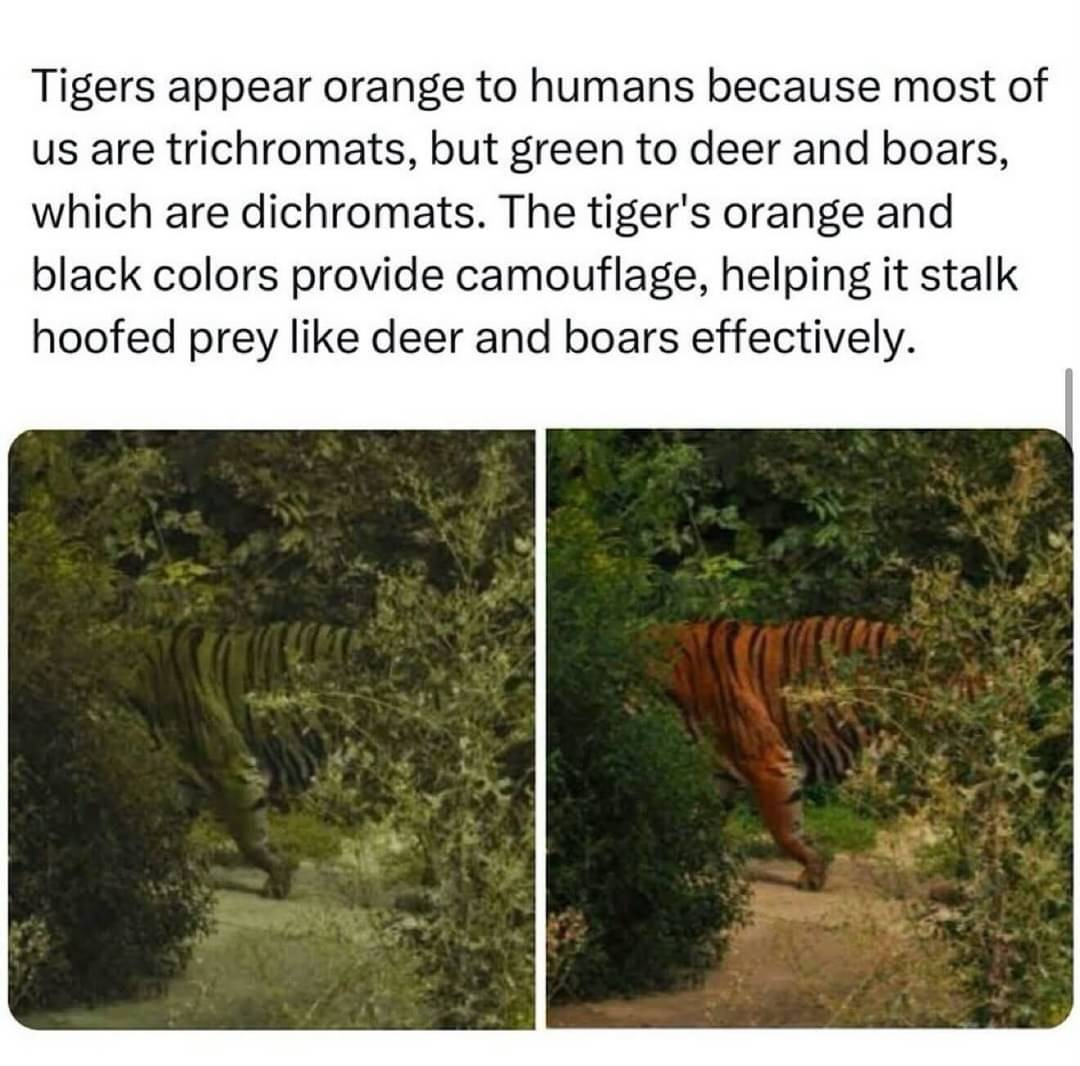This is also why hunting vests are bright orange. Easy for humans to spot, and deer get confused by there being a fucking tiger loose in New England.
Apparently pink works as well, if a hunter wants a second color vest
That works on the same principle, except the deer thinks you're a panther.
I always wondered about that, thanks.
So was it just random that their fur is orange and not green? As both would help hunt prey just as well. Or is the advantage of being orange, that it wards away other tigers and predators that might otherwise muscle into its territory and create conflict.
It’s also orange because mammals can’t produce green pigments, so orange is the next best thing if your prey is red-green colorblind.
more accurately, orange pigments are readily available. Nothing fundamentally stops mammals (or anything else) from developing a green. Note for example many animals have green eyes.
From what I understand green eyes are a bit weird as far as coloration goes, as they look green due to the way light is interacting with small amounts of melanin in the iris (the same pigment that makes eyes brown) rather than due to green pigment. I’m not sure that could be replicated in fur vs in a liquid environment like with the eye.
Birds mimic green colored pigments with iridescence (except turacos, they have green pigments for real) in their feathers, but I’m not sure that’s something mammals can do structurally in fur the way birds can in feathers.
This is probably an example of natural evolution/selection where tigers that had slowly evolved more orange in their fur naturally, were able to feed more. This in turn meant the orange triat in their genes was passed on more frequently and became more dominant in the population.
In a sense it was probably a "random" mutation, but when it became useful and effective it was passed down quicker.
But deer vision is immutable god creation. Checkmate.
Are there any green animals that aren't reptiles, birds or insects? That might be a clue.
Yellows and browns and orange are a lot more related, and whatever color the pre-orange tiger ancestor was, it was almost certainly one of those.
Natural variation in the coat means some of those tigers were more orange than their peers. This trait was selected for.
Probably both, except within the bounds of easily 'random' bounds. Supposing it were possible for a mammal to be green, it wouldn't matter of green were 'better', unless it happened at the right time. Orange could have won out simply because it was good enough to do one thing (camoflauge for pretty) and didn't have enough downside to message that benefit (high visibility to hunters or less valuable prey). Heck, a gene that turned a lion invisible could have turned up and it wouldn't be guaranteed to carry forward even if it didn't have any downsides if the random recipient also happened to be clumsy or unlucky and died of some random injury or disease.
Evolution doesn't really have any tools that aren't random, at least until intelligence came around to provide other 'non natural' paths, though of course those are just as natural as the others, just that we think we're special and above nature.
Meanwhile my colorblind ass:

Do tigers themselves see themselves as orange, or are they genuinely surprised when humans easily spot them hiding in the grass?
My cats are surprised both by me seeing them sitting on an empty floor, and by other cats who they didn't see sitting on the floor.
So I can only conclude the answer is semi-perpetual amazement.
The green image of the tiger is terrifying. You wouldn't see it until it's eyes or teeth were baring down on you in a lush green forest. Thankfully humans weren't it's main prey and therefore it likely evolved to appear orange instead...
I'm colorblind and the images are nearly identical. Good thing I'm not in tiger habitats very often.
Same. Didn't even realise they were different images until after I read the text.
Tigers are generally crepuscular which means they’re most active around dawn or dusk, when the sun is very low in the sky. Their orange fur does not stand out so well when everything looks orange under the golden light of dawn.
Thank you, evolution, for allowing me to see orange so I can get an head start and outrun a mother fucking tiger!
outrun a mother fucking tiger
You only need to outrun your travelbuddy.
Is that why cats can be so ginger and still good hunters? My orange stands out so much in the garden, but maybe to dichromatic mice he's super stealthy?
Wouldn't a mutation in the deer sight to see orange be vastly evolutionary beneficial?
Only in areas with tigers, and then it would only express itself enough if there were enough evolutionary pressure exclusively on that survival tactic.
As long as other causes of death happen to deer in tiger territories and as long as speed remains a good survival strategy, minor mutations that would only provide an advantage in extreme specific scenarios like a tiger stalking them wouldn't have a chance to be spread.
There's also a whole host of additional brain power that needs to be dedicated to more complex colour blending and processing, and that may add enough delay to offset any potential gain in recognizing a threat.
Presumably yes, but its still down to a roll of the dice whether a mutation like that happens in the first place, and whether the individuals who have that mutation live long enough to breed, and whether that mutation actually gets passed down, etc
Do the tigers know they are orange?
No, they too are dichromats
Desperately need me a community just for tiger facts like this and pictures of tigers. Greatest of the Big Cats
Oooh I just thought nature was fucking stupid
This must be utterly terrifying for them.
this sounds dumb. if that was the reason then why arent they just green so that theyre camoflaged to EVERY animal and not just those with bad eyes
Mammals don't come in green. We have 2 colours available to us, in different amounts: eumelanin, which is dark brown to black, and pheomelanin, which is yellow/red. We can mix those up in any way, or none (for white), but it'll never be green.
Now, many other animals don't have green either, peacock feathers for example, have brown pigment, but they have a structure that makes it look green and blue from wave interference.
Unfortunately, you can't really do that with fur, since you need to look at fur from all directions, not just the front.
So, mammals don't get green fur.
Then how do you explain this?

Damn.
Evolution is throwing things against the wall and seeing what sticks (by sticking I mean reproducing bc you have better traits). If every single one of their prey and predators have this color blindness then orange and green would have the same effectiveness and whichever trait comes out first. If a prey/predator evolved to have better color vision then it would quickly become a disadvantage and after millions of years it's possible they evolve to have green fur.
There could be other benefits like being easier to attract mates.
Also some animals can see infrared, so even if their fur was perfect for the environment they could still have issues by being spotted, in which case the color doesn't matter as much and the colors for mating becomes more important.
Edit: Wording.
A) Evolution is not directed. If a pre-tiger happens to be a more advantageous colour, it will have more offspring. There is no goal.
B) An orange tiger has the same camouflage from its prey's point of view as a green one, which is the thing that really matters. There is only one species a tiger is afraid of, and it's humans. I would wager that the orange also happens to act as a signal colour, both to other tigers and other predators (such as humans). Less run-ins and less territorial dispute sound pretty good.
Science Memes
Welcome to c/science_memes @ Mander.xyz!
A place for majestic STEMLORD peacocking, as well as memes about the realities of working in a lab.

Rules
- Don't throw mud. Behave like an intellectual and remember the human.
- Keep it rooted (on topic).
- No spam.
- Infographics welcome, get schooled.
This is a science community. We use the Dawkins definition of meme.
Research Committee
Other Mander Communities
Science and Research
Biology and Life Sciences
- !abiogenesis@mander.xyz
- !animal-behavior@mander.xyz
- !anthropology@mander.xyz
- !arachnology@mander.xyz
- !balconygardening@slrpnk.net
- !biodiversity@mander.xyz
- !biology@mander.xyz
- !biophysics@mander.xyz
- !botany@mander.xyz
- !ecology@mander.xyz
- !entomology@mander.xyz
- !fermentation@mander.xyz
- !herpetology@mander.xyz
- !houseplants@mander.xyz
- !medicine@mander.xyz
- !microscopy@mander.xyz
- !mycology@mander.xyz
- !nudibranchs@mander.xyz
- !nutrition@mander.xyz
- !palaeoecology@mander.xyz
- !palaeontology@mander.xyz
- !photosynthesis@mander.xyz
- !plantid@mander.xyz
- !plants@mander.xyz
- !reptiles and amphibians@mander.xyz
Physical Sciences
- !astronomy@mander.xyz
- !chemistry@mander.xyz
- !earthscience@mander.xyz
- !geography@mander.xyz
- !geospatial@mander.xyz
- !nuclear@mander.xyz
- !physics@mander.xyz
- !quantum-computing@mander.xyz
- !spectroscopy@mander.xyz
Humanities and Social Sciences
Practical and Applied Sciences
- !exercise-and sports-science@mander.xyz
- !gardening@mander.xyz
- !self sufficiency@mander.xyz
- !soilscience@slrpnk.net
- !terrariums@mander.xyz
- !timelapse@mander.xyz
